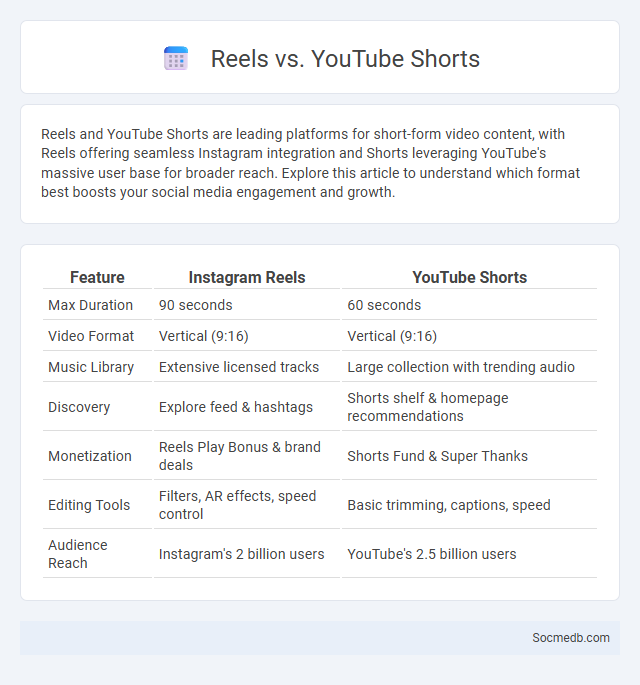
Photo illustration: Reels vs YouTube Shorts
Reels and YouTube Shorts are leading platforms for short-form video content, with Reels offering seamless Instagram integration and Shorts leveraging YouTube's massive user base for broader reach. Explore this article to understand which format best boosts your social media engagement and growth.
Table of Comparison
| Feature | Instagram Reels | YouTube Shorts |
|---|---|---|
| Max Duration | 90 seconds | 60 seconds |
| Video Format | Vertical (9:16) | Vertical (9:16) |
| Music Library | Extensive licensed tracks | Large collection with trending audio |
| Discovery | Explore feed & hashtags | Shorts shelf & homepage recommendations |
| Monetization | Reels Play Bonus & brand deals | Shorts Fund & Super Thanks |
| Editing Tools | Filters, AR effects, speed control | Basic trimming, captions, speed |
| Audience Reach | Instagram's 2 billion users | YouTube's 2.5 billion users |
Introduction to Short-Form Video Platforms
Short-form video platforms like TikTok, Instagram Reels, and YouTube Shorts have revolutionized social media by enabling users to create and share engaging, bite-sized content quickly. These platforms excel in capturing audience attention through creative, visually dynamic clips typically lasting between 15 to 60 seconds. Your brand can leverage short-form video to boost engagement, increase reach, and connect with a younger, trend-savvy audience.
What Are Instagram Reels?
Instagram Reels are short-form, engaging videos lasting up to 90 seconds, designed for users to create and share creative content through editing tools, audio tracks, and effects. These videos appear in a dedicated Reels tab on user profiles and are discoverable on the Explore page, increasing visibility and engagement. Reels offer brands and influencers a powerful opportunity to reach wider audiences through trending challenges, hashtags, and viral content formats.
YouTube Shorts: An Overview
YouTube Shorts is a short-form video platform designed for quick, engaging content under 60 seconds, optimized for vertical viewing on mobile devices. It leverages YouTube's vast user base, offering creators opportunities to reach millions with viral, bite-sized videos enhanced by music, effects, and editing tools. Your participation in YouTube Shorts can boost visibility and engagement, making it a powerful tool for brand growth and audience connection in the social media landscape.
Key Features Comparison
Social media platforms differ significantly in user interface, content formats, and audience engagement tools, with Facebook emphasizing community groups and long-form posts, Instagram prioritizing visual storytelling and Reels, and Twitter excelling in real-time updates and trending topics. Each platform offers unique advertising solutions tailored to different target demographics and business goals, enhancing your brand visibility through precise audience targeting and analytics. Understanding these key features helps you select the most effective social media channel to maximize engagement and drive growth.
Audience Demographics and Reach
Social media platforms attract diverse audience demographics, spanning age groups, interests, and geographic locations, which allows businesses to target specific segments with tailored content. Platforms like Facebook and Instagram boast billions of active users monthly, offering vast reach potential for brand visibility and engagement. Understanding audience demographics enhances campaign effectiveness by aligning messaging with user preferences and online behaviors.
Content Creation Tools and Editing
Content creation tools and editing software have revolutionized social media by empowering users to produce high-quality visuals and videos with ease. Platforms like Adobe Premiere Pro, Canva, and Final Cut Pro offer advanced features such as layering, special effects, and intuitive drag-and-drop interfaces that streamline the editing process. These tools enhance engagement by enabling creators to tailor content to platform-specific formats and audience preferences, driving higher interaction rates across Instagram, TikTok, and YouTube.
Monetization Options for Creators
Social media platforms offer various monetization options for creators, including ad revenue sharing, sponsored content, and fan subscriptions. You can leverage features like YouTube's Partner Program, Instagram's branded content tools, and TikTok's Creator Fund to generate income from your audience. Exploring affiliate marketing and direct merchandise sales further expands your revenue streams on social media.
Algorithm and Discoverability
Social media algorithms analyze your behavior, preferences, and interactions to curate personalized content feeds, enhancing the relevance of what you see. Understanding these algorithms can significantly improve your content's discoverability by optimizing timing, hashtags, and engagement strategies. Ensuring your posts align with trending topics and user interests boosts visibility and fosters organic growth on platforms like Instagram, TikTok, and Facebook.
Pros and Cons of Each Platform
Facebook excels in connecting diverse age groups and fostering community engagement but struggles with privacy concerns and misinformation spread. Instagram offers powerful visual storytelling and influencer marketing opportunities, yet it can contribute to mental health issues due to unrealistic beauty standards and algorithm-driven content loops. Twitter provides real-time news updates and direct interaction with public figures while grappling with harassment, misinformation, and character limits that constrain detailed discussions.
Choosing the Best Platform for Your Brand
Choosing the best social media platform for your brand depends on understanding your target audience's demographics, interests, and online behavior. Platforms like Instagram and TikTok excel for visual and younger audiences, while LinkedIn targets professionals and B2B engagement effectively. Your brand's content style and marketing goals should align with the platform's unique features to maximize reach and engagement.
 socmedb.com
socmedb.com